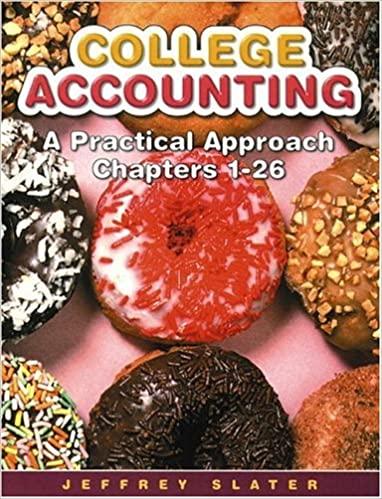Answered step by step
Verified Expert Solution
Question
1 Approved Answer
The income statement makes all sales and purchases on account, Any equipment purchases made during the year were in cash. 1.Open one ledge account for
The income statement makes all sales and purchases on account, Any equipment purchases made during the year were in cash.
1.Open one ledge account for each balance sheet account and one for each income statement account.
2. Use the income statement, balance sheet, and supplemental information to explain what happened to each account during the year
3. Classify each cash transaction as O,I, or F
4. Prepare a Direct statement of Cash Flows
use pictures included please


Problems for Section 5A 5A-1. The comparative balance sheet for TYPICAL Incorporated is shown below for January 1, 20x1, and December 31, 20x1. The income statement for 20x1 is also shown. TYPICAL makes all sales and purchases on account. Any equipment purchases made during the year were in cash. ! December 31 TYPICAL INCORPORATED Comparative Balance Sheet January 1 and December 31, 20x1 January 1 Assets Cash Y $ 5,000 Accounts receivable 3,000 upplies D o 1,000 Plant & equipment 7,000 Accumulated depreciation 0 Total Assets to $16,000 $ 3,000 7,000 6,000 17,000 (3,000) $30,000 $ 1,000 Liabilities & Owners' Equity Accounts payable Wages payable Total Liabilities $ 0 2,000 $ 2,000 $ 1,000 Common stock Retained earnings Total Liabilities & Owners' Equity 10,000 5,000 $16,000 16,000 12,000 $30,000 5A-12 TYPICAL INCORPORATED Income Statement Year Ending December 31, 20x1 Revenue $34,000 s Expenses: Supplies expense Wage expense Depreciation expense Net Income (15,000) ( 9,000) ( 3,000) $ 7,000 Required: 1. Open one ledger account for each balance sheet account and one for each income statement account. (Note: in a statement of cash flows problem you sometimes have to add a few additional T-accounts - the template provided has enough accounts necessary to work this particular problem.) Enter the 20x1 beginning and ending balances for each permanent account. 2. Use the income statement, balance sheet, and supplemental information to explain what happened to each account during the year - some intelligent guessing might be required at this point. 3. Classify each cash transaction as operating (0), investing (I), or financing (F), and write out the use or source of the cash involved. 4. Prepare the 20x1 statement of cash flows for TYPICAL Incorporated. Problems for Section 5A 5A-1. The comparative balance sheet for TYPICAL Incorporated is shown below for January 1, 20x1, and December 31, 20x1. The income statement for 20x1 is also shown. TYPICAL makes all sales and purchases on account. Any equipment purchases made during the year were in cash. ! December 31 TYPICAL INCORPORATED Comparative Balance Sheet January 1 and December 31, 20x1 January 1 Assets Cash Y $ 5,000 Accounts receivable 3,000 upplies D o 1,000 Plant & equipment 7,000 Accumulated depreciation 0 Total Assets to $16,000 $ 3,000 7,000 6,000 17,000 (3,000) $30,000 $ 1,000 Liabilities & Owners' Equity Accounts payable Wages payable Total Liabilities $ 0 2,000 $ 2,000 $ 1,000 Common stock Retained earnings Total Liabilities & Owners' Equity 10,000 5,000 $16,000 16,000 12,000 $30,000 5A-12 TYPICAL INCORPORATED Income Statement Year Ending December 31, 20x1 Revenue $34,000 s Expenses: Supplies expense Wage expense Depreciation expense Net Income (15,000) ( 9,000) ( 3,000) $ 7,000 Required: 1. Open one ledger account for each balance sheet account and one for each income statement account. (Note: in a statement of cash flows problem you sometimes have to add a few additional T-accounts - the template provided has enough accounts necessary to work this particular problem.) Enter the 20x1 beginning and ending balances for each permanent account. 2. Use the income statement, balance sheet, and supplemental information to explain what happened to each account during the year - some intelligent guessing might be required at this point. 3. Classify each cash transaction as operating (0), investing (I), or financing (F), and write out the use or source of the cash involved. 4. Prepare the 20x1 statement of cash flows for TYPICAL Incorporated
Step by Step Solution
There are 3 Steps involved in it
Step: 1

Get Instant Access to Expert-Tailored Solutions
See step-by-step solutions with expert insights and AI powered tools for academic success
Step: 2

Step: 3

Ace Your Homework with AI
Get the answers you need in no time with our AI-driven, step-by-step assistance
Get Started


